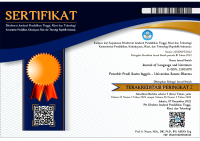Happiness, Love, and Friendship as Grotesque Imagery in Oscar Wilde’s Fairy-Tales: Bakhtinian Perspective
(1) Universitas Gadjah Mada
(2) Universitas Gadjah Mada
(*) Corresponding Author
Abstract
Keywords
Full Text:
PDFReferences
Bakhtin, M. (1984). Rabelais and His World. Indiana University Press.
Brett, B. M., & Huck, C. S. (1982). Children’s Literature— The Search for Excellence. Language Arts, 59(8), 877–882. http://www.jstor.com/stable/41405125
Dobrodum, O. (2023). The Problem of Death and Immortality in the Material of Oscar Wilde’s Tale “The Selfish Giant.” Вісник Львівського Університету, 1(51), 42–46. https://doi.org/https://doi.org/10.30970/PPS.2023.51.5.
Duffy, J.C. (2001). Gay Related Themes in the Fairy Tales of Oscar Wilde. Victorian Literature and Culture. 29(2), 327-349. https://doi.org/10.1017/S1060150301002054
Epstein, V. B. (1986). Moral Reading: Children’s Literature as Moral Education. Children’s Literature Association Quarterly, 11(2), 68–72. https://doi.org/10.1353/chq.0.0497
Fonseka, G. (2020). Sacrifice Unacknowledged: A Literary Analysis of “The Nightingale and the Rose” by Oscar Wilde. American Research Journal of English and Literature, 6(1), 1–8. https://doi.org/10.21694/2378-9026.20010
Leite, F. B. (2023). Grotesque Realism and Grotesque Body in Bakhtin. Bakhtiniana, 18(4). https://doi.org/10.1590/2176-4573e62064
Lerer, S., (2008). Children’s Literature: A Reader’s History, from Aesop to Harry Potter. The University of Chicago Press. USA.
Nha, C. T., & Hoa, H. T. (2020). Social Criticism Towards Late Victorian Society and the Theme of Sacrifice in Oscar Wildes the Happy Prince. International Journal of Advanced Research, 8(10), 08–11. https://doi.org/10.21474/ijar01/11816
O’Malley, A. (2012). Children ’ s Literature , Popular Culture , and Robinson Crusoe Utopian Transformations. Palgrave MacMillan. London
Omar, S. H. (2018). The Nature of Sacrifice in O Henry’s The Gift of the Magi, Wilde’s The Nightingale and the Rose, and Ibsen’s A Doll’s House. Journal of Garmian University, 5(1), 25–33. https://doi.org/10.24271/garmian.301
Pease, A. (2004). Aestheticism and Aesthetic Theory. In F. S. Roden (Ed.), Palgrave Advances in Oscar Wilde Studies (pp. 96–118). Palgrave. https://doi.org/10.5860/choice.42-5121
Poorghorban, Y. (2022). The Commodified Happiness: The Only Established Source of Meaning in Oscar Wilde’s The Happy Prince and The Nightingale and the Rose . Prague Journal of English Studies, 11(1), 51–65. https://doi.org/10.2478/pjes-2022-0003
Rae, H. (1998). The Politics of Monstrosity : Giant Bodies and Behaviour in Classical and Renaissance Literature and Art. North, 16, 1–23. https://www.gla.ac.uk/media/Media_180311_smxx.pdf
Reynolds, K. (2007). Radical Children’s Literature: Future Visions and Aesthetic Transformations in Juvenile Fiction. London: Palgrave MacMillan.
Ricoeur, P. (2021). Hermeneutika dan Ilmu-Ilmu Humaniora. Yogyakarta: IRCiSoD.
Short, K. G. (2018). What’s Trending in Children’s Literature and Why It Matters. Language Arts, 95(5), 287–298. https://doi.org/10.58680/la201829584
Wilde, O. (2008). The Happy Prince and Other Tales. The Floating Press.
Wilde, O. (2020). The Soul of Man Under Socialism. Salatiga: Penerbit Parabel.
DOI: https://doi.org/10.24071/joll.v25i1.9416
Refbacks
- There are currently no refbacks.

This work is licensed under a Creative Commons Attribution-ShareAlike 4.0 International License.
Journal of Language and Literature (JOLL) is published by Prodi Sastra Inggris, Fakultas Sastra, Universitas Sanata Dharma.
JOLL is indexed in:

This journal is is licensed under a Creative Commons Attribution-ShareAlike 4.0 International License












